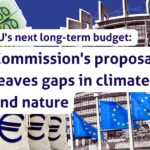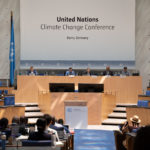Since EU governments started negotiating their position on the revision of the bloc’s energy efficiency laws, proposals have been going from bad to worse. Member states have to step their game up, warns Dora Petroula.
This op-ed was first published on Euractiv on 17 May 2017
Tomorrow the negotiations will reach the Energy Ministers at the Informal Energy Council. So far, talks on the European Commission’s proposal for a review of the Energy Efficiency Directive (EED) have been moving in the wrong direction.
EU countries are considering diluting the Commission’s already weak 2030 30% energy efficiency target by suggesting it should not be binding. They are also seeking ways to water down the cornerstone of the EED – the requirement to save energy every year.
Thanks to the EED, member states have to save energy that corresponds to 1.5% of energy sold to consumers every year. On the ground, this can translate into support for home insulation, double-glazing installation, or more efficient appliances and heating systems.
Member states can choose different ways to fulfil this obligation. They can choose to establish an Energy Efficiency Obligation (EEO) scheme.
Under such schemes companies that supply, sell or distribute energy have to deliver the required savings by helping citizens and businesses improve energy efficiency and reduce energy waste at home or at work.
Countries can also enact other policies, such as providing funding opportunities for the renovation of buildings.
The requirement to save energy every year was put in place to accelerate action on energy efficiency. Evidence so far indicates that it is working.
Member states have planned nearly 500 measures to meet the requirement. The majority of them target the building sector. According to national experts, the obligation helped create new business models for energy efficiency.
Current evidence also shows that the cost of saving one unit of energy is much lower than the cost of supplied energy. The multiple benefits of energy efficiency, such as reduced greenhouse gas emissions and air pollution, increased comfort, job creation and improved competitiveness make the case for the savings obligation even stronger.
One would expect that member states would be happy to improve upon this existing energy efficiency legislation. Yet despite the benefits, countries are considering lowering the annual savings objective from 1.5 to 1.4% after 2020 and removing a provision that would ensure that the requirement to deliver energy savings will continue beyond 2030.
Member states use the need for more flexibility as an excuse. But flexibility does not mean doing less, it means having the freedom to decide how to deliver the required savings. The legislation is built with this in mind, as countries can choose different measures to address their national circumstances.
In addition, countries are already allowed to reduce their efforts by using a set of loopholes. These loopholes reduce the average savings to be delivered to 0.75% per year instead of the envisaged 1.5%.
At the moment, there is hardly any discussion on the need to raise the level of ambition of the Commission’s weak proposal, for instance by closing the loopholes. Yet strong action on energy efficiency is absolutely necessary for achieving the goals of the Paris Agreement. Energy efficiency is the most direct way to reduce greenhouse gas emissions.
The race to weaken the legislation will not stop unless governments step up to the plate and defend ambition on energy efficiency.
We need champions that will prevent the savings obligation from being watered down and support the tools we have to speed up the energy transition. Now it is the time to take advantage of the opportunities from the Paris Agreement.



